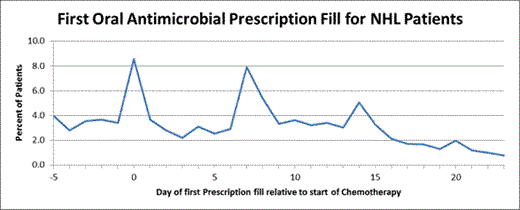Abstract
Introduction: Febrile neutropenia and hospitalizations for infection are serious potential complications of myelosuppressive chemotherapy treatment in cancer patients. Oral antimicrobial use may provide effective prophylaxis against these complications in the elderly population. The available literature provides a limited description of antimicrobial use in elderly patients with non-Hodgkin lymphoma (NHL) receiving chemotherapy.
Objectives: Describe the use patterns of oral antimicrobial agents in elderly patients with NHL on chemotherapy.
Methods: The study population included non-HMO enrollees in the 20% Medicare sample with Parts A, B, and D coverage who had NHL and initiated their first course of chemotherapy between July 1, 2007, and November 30, 2011. We searched Part D claims for oral antimicrobial agents from 5 days before chemotherapy initiation to the end of the first cycle. We examined type of antimicrobial agents prescribed and timing of first prescription fill relative to chemotherapy initiation. Counts and percentages were estimated.
Results: The study cohort included 6306 patients with NHL; 1682 patients (26.7%) had at least one prescription fill for an oral antimicrobial agent during the first cycle, for an overall total of 2569 claims for antimicrobials. Of these, 77.1% were for antibacterial, 9.9% for antifungal, and 13.1% for antiviral agents. Of antibacterial claims, 44.3% were for fluoroquinolones, 16.2% for sulfonamides, 12.0% for penicillins, and 12.0% for cephalosporins. First prescription fill occurred in the 5 days before the start of the first cycle for 17.4% of patients, from day 0 (the beginning of the cycle) to day 5 for 22.9%, and from day 6 to the end of the cycle for 59.7%. Peak days for first prescription fill were days 0, 7, and 14 of the first chemotherapy cycle (Figure).
Conclusions: Over 25% of elderly NHL patients filled prescriptions for oral antimicrobial agents during the first cycle of chemotherapy. Since these data represent the fill date and not the date a patient started taking the medicine, it is possible that all fills in the 5 days before day 0 were to be started on day 0. Under this assumption, about 26% of prescriptions were started at the beginning of the cycle, likely for prophylaxis, and the remaining (especially peaks on days 7 and 14) may reflect either prophylaxis or treatment for an active infection. The literature suggests that peak infection risk occurs between days 7 and 16 of the chemotherapy cycle. Current antibiotic use patterns may not be optimal for patient care.
Note: 114 patients had their first oral antimicrobial prescription fill after day 23, but these results could not be shown because there were fewer than 11 patients on each of those days.
Page:Amgen Inc.: Employment, Equity Ownership. Barron:Amgen Inc.: Employment, Equity Ownership. Morrow:Amgen Inc.: Employment, Equity Ownership. Stryker:Amgen Inc.: Employment, Equity Ownership. Acquavella:Amgen Inc.: Employment, Equity Ownership. Collins:ZS Pharma Inc.: Consultancy; Keryx Biopharmaceuticals, Inc.: Consultancy; Amgen Inc.: Consultancy; NxStage Medical Inc.: Consultancy.
Author notes
Asterisk with author names denotes non-ASH members.


This feature is available to Subscribers Only
Sign In or Create an Account Close Modal